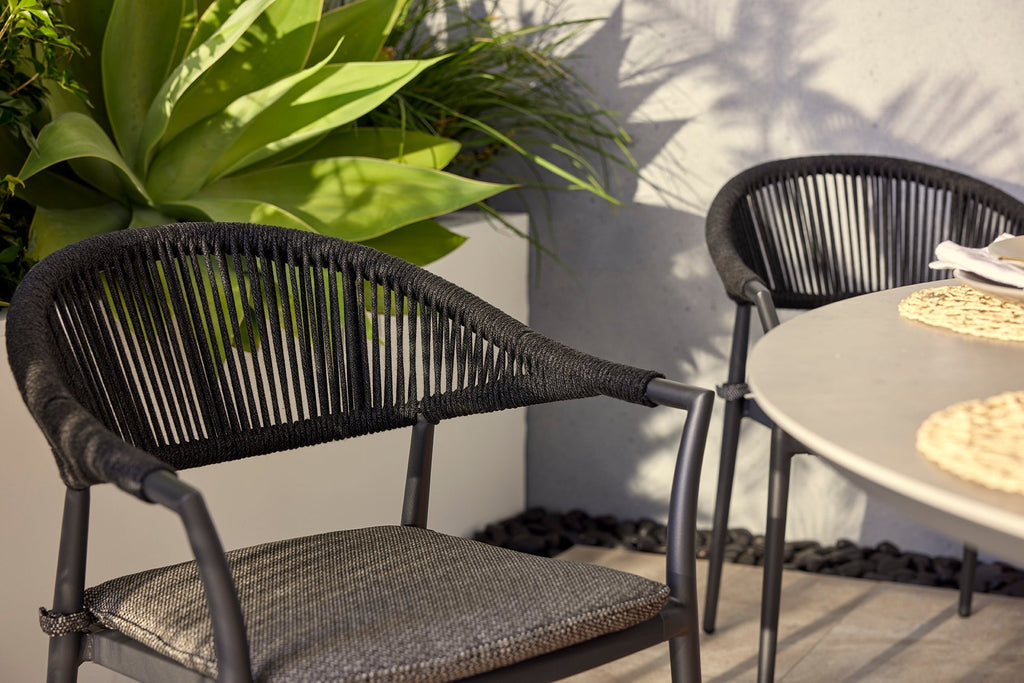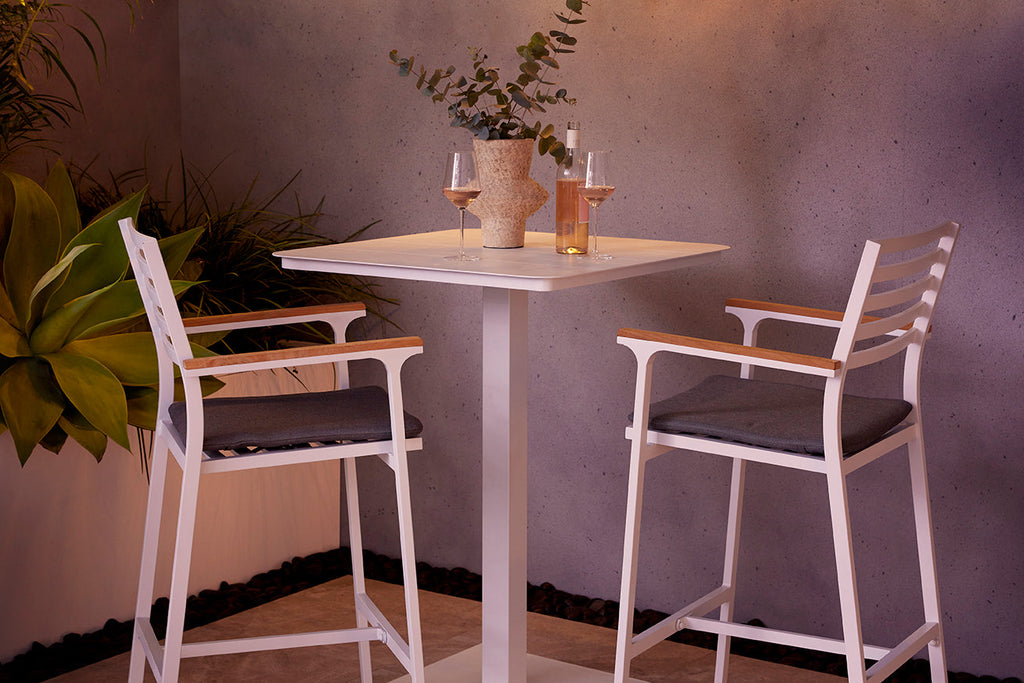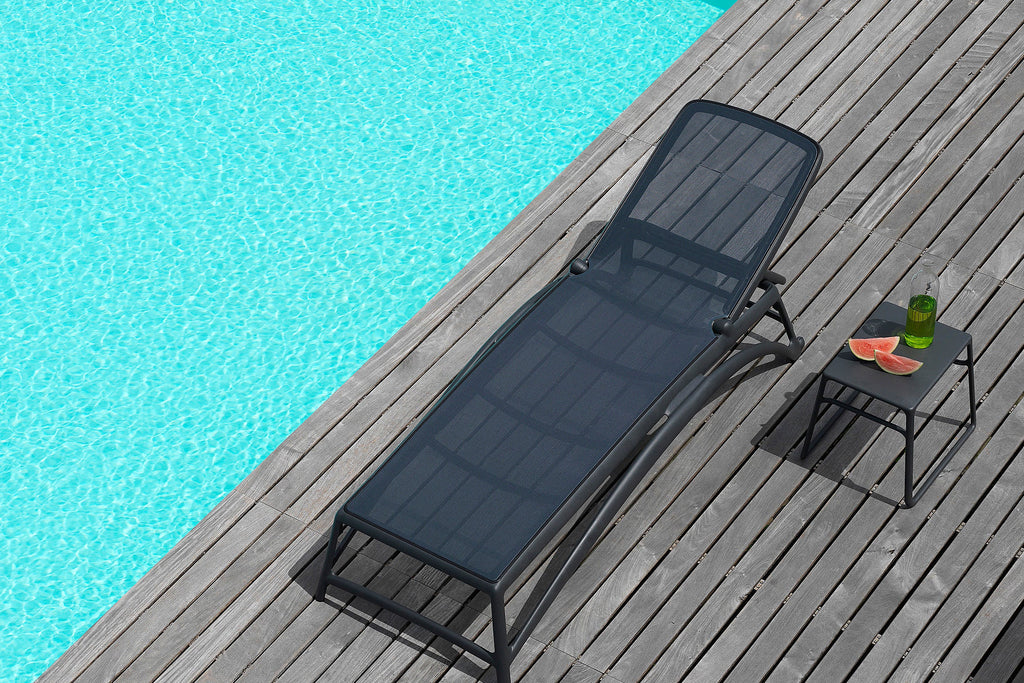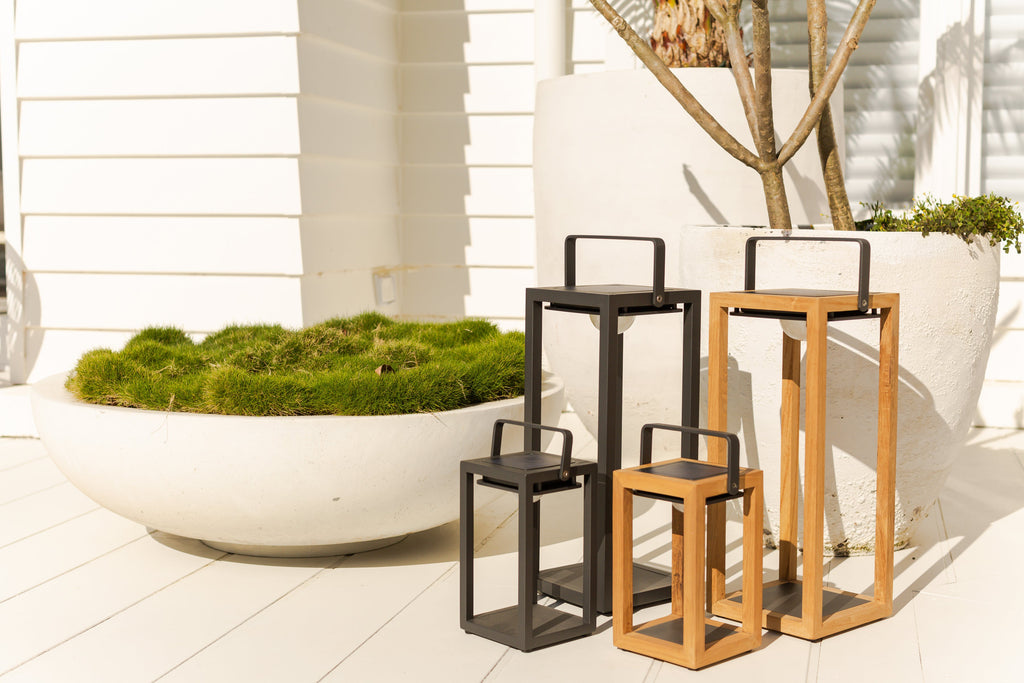How to Clean Outdoor Cushions: Expert Guide
Key Highlights
- Regular cleaning and protection prevent stains, mould, and wear.
- Always check fabric care labels before cleaning.
- Test stain removers on a small area first.
- Avoid wringing cushions; press out excess water instead.
- Use a fabric protector spray to repel future stains.
- Choose the best cleaning method (hand washing, machine washing, or pressure washing) based on your cushion type (recommendations below).
- Different stains need specific cleaners and methods - bird droppings, mould, mildew, food, and grease all respond differently.
Introduction
Comfortable furnishings are essential for any outdoor space, but many people are unsure of how to clean outdoor cushions so they stay looking fresh and feeling great. With this guide, you can become an expert in using vinegar, OxiClean, your washing machine, and other simple ingredients to keep your outdoor cushions looking vibrant, and extend their lifespan for years to come. If you’ve created a beautiful European style space outside using our products, you want it to look amazing for as long as possible.
Outdoor cushions can be exposed to the harsh Australian weather, as well as dirt, mildew, and stains; they face a lot of wear and tear. It can be difficult to get them clean without risking damaging the fabric. However, this guide is going to give you step-by-step methods for cleaning outdoor cushions, with options like hand-washing, machine washing, and pressure washing, so you can choose the best approach for cleaning your cushions. In addition, we’ll cover all kinds of different contaminants, including bird droppings, grease, and mould. For hand-washing, we’ve even included an easy-to-follow infographic below to guide you through the process.
But how do we know what we’re talking about? As an Australian outdoor furniture company with more than 25 years of experience bringing classic European styles to people’s outdoor spaces, we offer, and for years have sold a wide range of outdoor cushions, and we know what it takes to keep them looking their best, safely and effectively. If you want your outdoor space to be clean and tidy and you want your cushions to last longer, keep reading to find out all our practical tips. You can also check out our Magic Stain Remover and our Golden Care outdoor fabric protector to see if they could quickly help eliminate stains from your outdoor fabrics!
Choosing the Best Cleaning Method for Outdoor Cushions

So, what approach should you be taking? Hand washing? Machine washing? Or is pressure washing the best option? It depends on the circumstances! Here are our suggestions.
Hand Washing
If you're wondering how to clean outdoor cushions, hand washing is probably the first thing you'll think of. This is gentle on fabric, so it's ideal if your cushions are delicate. However, it will work best if the stains are minor and still wet, and it does tend to take longer than other choices. If you've got a lot of cushions or they're big ones, it might not be the most practical solution, but it is the safest for preserving your fabrics.
Machine Washing
This involves less manual labour, so might be preferable for some people. You can use it if your cushions have removable covers that can be put in the machine, although you will need to check the labels first for any instructions. It's an efficient option that will get out tougher stains, and the cushions may dry faster than with hand washing.
However, it's a bit tougher on fabrics and may damage low-quality ones. It often won't work for cushions themselves, so you can only use it if the covers are removable and machine-safe.
Pressure Washing
If your cushions are very big or they've got large, heavy stains on them, pressure washing may be your best option. This is a much harsher cleaning method so be aware that it has the potential to damage fabrics. It's fast and powerful, but you'll need to be careful and not put the nozzle closer than 6 inches (around 16 cm) from the fabric, or you'll be at risk of damaging it!
Hand Washing
Equipment/Tools:
- Gloves
- Water spray bottle
- Brush
- Mild dish detergent (for oils and food stains)
- Additional detergent (if needed)
- Garden hose
- Fabric Protection Spray (optional)
- Magic Stain Remover (optional) (it’s also available at Woolies!)
Instructions:
-
Step 1: Preparation
- Choose a sunny day for cleaning so your cushions will dry nice and quickly. Slow drying can increase the risk of mildew forming. A good breeze will also help speed up drying times!
- Check if the cushion cover is removable. If so, take it off to be washed separately; this is often the easiest way to get it clean.
- Vacuum the cover's surface to remove any loose debris.
- Place the cover on a clean, flat surface (such as a clean patio or driveway, nowhere with mud or weeds).
- Spray the cushions with water.
-
Step 2: Cleaning Process
- Always check the cushion's care label before proceeding and follow any specific instructions.
- If the cushion has stubborn stains, use Magic Stain Remover and let it sit for 2+ minutes. To do this:
- Shake the bottle and unlock the sprayer by pushing the button above the bottle's neck.
- Blot the stain to remove any residue.
- Apply the stain remover.
- Work the solution into the fabric and let it sit for 1-5 minutes (or up to 10 minutes for stubborn stains).
- Blot with water using a cloth/sponge.
- Repeat if necessary.
- Once the stain has been treated, apply dish soap evenly across the cushions with a brush.
- Scrub thoroughly to create foam, especially in mouldy areas.
- Let it sit for 5-10 minutes.
Pro tip: Avoid using a harsh brush to scrub the cushion; you may damage the fabric. Opt for soft bristles or even a cloth.
-
Step 3: Rinsing
- Rinse the cushion thoroughly with a hose to remove the detergent.
- Ensure there are no white traces left after the cushion is dry.
Pro tip: When you've finished rinsing, you can use a towel to gently press out extra water. Avoid wringing the cushions out, as this might damage their shape and/or the fabric.
-
Step 4: Protection (Optional)
- Spray the whole cushion's surface with fabric protection spray to create a protective layer (recommended).
-
Step 5: Drying
- Press the cushions by hand to remove moisture.
- Hang cushions in a sunny area to dry completely.
Pro tip: Cushions will dry faster if there's a breeze, so prop them up and put them somewhere with good air circulation.
Step-by-Step Infographic
Check out our infographic below for a simple, step-by-step guide on how to hand wash your outdoor cushions, helping to keep them clean and durable over time. For more detailed written instructions, feel free to scroll back up.

Machine Washing
When it comes to the question of how to clean outdoor cushions, while much easier than hand washing, machine washing does come with a few caveats. You will usually only be able to wash cushion covers this way (the cushion's label should make it clear if the whole cushion can be washed) and frequent machine washing may eventually degrade the fabric. Instead of always machine washing cushions, consider spot cleaning to get rid of minor stains.
Use the table below for a simple breakdown of some fabric types and the best machine-washing settings for each.
| Fabric Type | Machine Washable? | Recommendations |
|---|---|---|
| Olefin | ✅ Yes |
|
| Acrylic | ✅ Yes |
|
| Polyester | ✅ Yes |
|
Equipment / Tools:
- Gloves
- Spray Bottle
- Mild Laundry Detergent
- Washing Machine
- Fabric Protection Spray (optional)
Instructions:
-
Step 1: Preparation
- Begin by placing the cushion on a clean surface such as a patio or terrace.
- Spray the cushions with water until they are thoroughly damp.
-
Step 2: Pre-Treatment
- Apply laundry detergent to the cushions using a soft brush and let it sit for 5-10 minutes.
-
Step 3: Machine Washing
- Place cushions in the washing machine.
- Check the maintenance label for cleaning instructions. You can also refer to the above table for specific material tips and recommended washing machine settings.
- Select a gentle cycle to avoid excessive vibration and deformation.
-
Step 4: Post-Wash Care
- When the wash has finished, gently tap or reshape the cushions to restore their original form and prevent shrinking or deformation.
-
Step 5: Protection (optional)
- Spray fabric protection spray over the entire cushion surface to create a protective layer (recommended).
-
Step 6: Drying
- Place cushions in a sunny area to dry completely. As with hand-washing cushions, good airflow will improve the drying times.
Removable Covers & Ironing:
- Some outdoor cushions and pillows have removable covers with a zipper, and these covers can often be machine-washed. Always check the manufacturer’s care label for washing instructions.
- For those without removable covers, the above step-by-step instructions are what you should follow.
- Pro tip: If you have washed only the cushion covers, you can allow them to air-dry completely before reattaching them, however, putting them back on the cushions when they are still damp (but not sodden) can actually reduce the risk of them shrinking and may ensure they retain their shape better.
- If your outdoor cushions have removable covers, you may wish to iron them, but make sure you use a low temperature (a high one may damage the fabric).
Pressure Washing
Disclaimer: If you're dealing with tough stains on your outdoor cushions, using a pressure washer might seem like an appealing option. However, before you start, check the cushion's care instructions, as not all will withstand this sort of treatment. Pressure washing creates a strong force that can damage both fabric and foam. This is particularly true for older cushions, where the components may already be weak. If you're not sure whether the cushion can be pressure washed, test a small inconspicuous area first, or opt for another cleaning method.
Pro tip: Don't use a steam washer unless the care instructions say otherwise, as the cushion may not withstand such high temperatures. The combination of force and heat can weaken fibres and might destroy the cushion, especially if it's older. Steam washing has benefits, but you should always proceed with caution!
Use the table below for a simple breakdown of some fabric types and the best pressure-washing settings for each.
| Fabric Type | Safe for Pressure Washing? | Recommendations and Precautions |
|---|---|---|
| Olefin | ✅ Yes, usually safe |
|
| Acrylic | ✅ Yes, usually safe |
|
| Polyester | ✅ Yes, usually safe |
|
Equipment / Tools:
- Gloves
- Garden Hose
- Pressure Washer
- Detergent
- Brush (if needed)
- Fabric Protection Spray (optional)
Instructions:
-
Step 1: Preparation
- Place cushions on a clean surface such as a patio or terrace.
- Spray the cushions with water until they are thoroughly damp.
-
Step 2: Pressure Washer Setup
- Pour detergent into the pressure washer’s storage tank.
- Connect the garden hose to the pressure washer and ensure the connection is secure.
- Adjust the water height to allow proper flow through the machine.
-
Step 3: Cleaning Process
- For specific cleaning settings and material tips, refer to the table above.
- For general guidance, follow these steps:
- Attach the cleaning nozzle to the pressure washer hose.
- Turn on the machine and spray each cushion thoroughly.
- Maintain an appropriate distance between the nozzle and the cushion to avoid fabric damage.
-
Step 4: Stubborn Stains
- Reapply detergent to stubborn stains and gently scrub them with a brush if needed.
- Rinse again with the pressure washer to remove all detergent residue.
-
Step 5: Protection (optional)
- Spray fabric protection spray over the entire cushion surface to create a protective layer (recommended).
-
Step 6: Drying
- Press cushions by hand to remove excess moisture.
- Hang cushions upright in a sunny area to dry completely.
Pro tip: Remember that you can press excess moisture out with an old towel, and should hang cushions somewhere with good airflow to improve drying.
How to Handle Common Outdoor Cushion Stains

Bird Droppings
If you have outdoor furniture, chances are you’ve had to deal with magpie, cockatoo or other bird droppings at some point. Bird droppings can be an issue because they contain uric acid, which is likely to stain the fabric. That's the white part you see in the droppings. Swift cleaning is therefore recommended.
Getting rid of these stains is usually best done using vinegar or detergent, as these will help break down the acid and loosen the droppings. Quick cleaning can also reduce the risk of the stain setting. If you've got any of our stunning commercial-grade, European-inspired pieces, it's worth the effort to get them looking good again! Here's how to clean bird poop off outdoor cushions quickly and safely using detergent.
Instructions:
- Wait for droppings to dry completely, then gently scrape them off using a spatula.
- Moisten the stained area, apply some detergent, and let it sit for 5-10 minutes.
- Gently scrub the area with a soft brush and rinse thoroughly.
- Spray on some fabric protection spray and dry the cushion in sunlight to prevent mould.
Mould & Mildew
If you're wondering how to clean the mould off outdoor cushions, you're far from alone. This is another common issue that can spoil even the most beautiful European-style outdoor furniture. First, let's understand what we're dealing with here. Many people use the terms "mould" and "mildew" interchangeably, but they're very different.
If your cushions are growing mould, you're likely to see green/black stains that go right through the fabric. Mildew, by contrast, tends to stay on the surface, and is usually grey or white. You can deal with them in similar ways, but mould may be harder to shift.
Instructions:
-
Prepare the Cleaning Solution:
- Fill a bucket with warm water.
- Add ½ cup of white vinegar and ½ cup of Vanish Oxi Action In-Wash Stain Remover (or a similar oxygen-based stain remover).
- Stir well until dissolved.
-
Scrubbing the Stains:
- Wet a soft-bristled brush (e.g., nail brush) in the solution.
- Gently scrub the affected area, ensuring the fabric is dampened before scrubbing.
- Always test on a hidden area first to check for fabric compatibility.
-
For Stubborn Stains:
- Apply a small amount of lemon juice and Vanish powder directly onto the stain.
- Let it sit for a few minutes, then repeat the scrubbing process.
-
Final Rinse & Drying:
- Rinse thoroughly with cold water.
- Leave cushions to dry flat in sunlight.
- If the covers are removable, wash them separately on a gentle 30°C cycle.
Grease, Oil, & Food Stains
If you enjoy meals outside or often wear sunscreen, chances are you’ll eventually deal with this type of stain. Fortunately, we've got you covered.
First, figure out what kind of stain you're dealing with. Oil-based stains, such as butter, sunscreen, and salad dressings will need a different treatment from protein-based stains like meat juice, milk, and eggs. For the former, an enzyme-based detergent or mild dish soap will often do the trick. For the latter, you should look for a fabric-safe oxygen bleach. Here's how to clean food stains off outdoor cushions effectively (oil-based stains).
Instructions:
- Blot excess oil with oil-absorbing paper or a clean cloth.
- Apply absorbent powder (e.g., cornstarch, baking soda) and let it sit for 15 minutes to draw out grease.
- Gently scrape off the powder with a spatula. Repeat if needed for heavy stains.
- Wipe the area with a cloth dipped in warm water and mild dish soap or enzyme-based detergent.
- Rinse thoroughly to remove any residue.
- Apply fabric protection spray and dry in sunlight to prevent future stains.
Recommended Detergent to Use on Cleaning Outdoor Cushions
For those wanting the most effective cleaning method tailored to their specific situation, different detergents work best for different stains and issues. Whether you're dealing with mildew, deep-set grime, or general dirt buildup, here are the top options to achieve the best results:
Vinegar
- Why Use Vinegar? It’s a natural, non-toxic, and eco-friendly cleaning solution. It’s ideal for removing bird droppings, mould, and mildew, and can even help prevent future outbreaks.
-
Steps for General Use:
- Mix 1/4 cup distilled white vinegar with 4 cups warm water in a spray bottle.
- Vacuum the surface before applying.
- Spray generously and let sit for 15 minutes.
- Scrub stained areas with a soft brush.
- Rinse with water and allow to air dry.
-
What to Consider Before Using Vinegar:
- It may not be strong enough for severe mould or mildew stains—consider using bleach for tough cases.
- It’s not ideal for some cushion fabrics, especially delicate materials, as prolonged exposure could cause discolouration or weaken fibres.
- Avoid using vinegar on natural stone surfaces (if cushions are placed on a stone patio) as it can cause etching.
Bleach
- Why Use Bleach? Bleach tends to be highly effective for severe mould, mildew, and stubborn stains. It kills bacteria and prevents future fungal growth, reducing the overall problem. It usually works well on white or colourfast outdoor fabrics that can tolerate strong cleaning agents.
-
Steps for General Use:
- Begin by placing the cushions on a tarp to protect the surface under them from the bleach.
- Make sure you’re wearing gloves, a mask, and goggles.
- Mix a gallon of water with a ¾ cup of bleach, then stir thoroughly.
- Dip a clean cloth into the mixture and wipe down the cushions, applying the solution thoroughly until the cushions are wet.
- Allow the solution to sit for 5 minutes.
- Thoroughly rinse the cushions with your garden hose, making sure all the bleach solution has been rinsed out. Allowing it to sit could weaken the fibres.
- Put the cushions in a sunny, breezy spot to dry.
-
What to Consider Before Using Bleach:
- Bleach can cause discolouration or fading on non-colourfast fabrics, so always do a patch test first.
- It’s harsh on delicate materials and may weaken fabric fibres over time; minimise use.
- It gives off strong fumes, so only use it in a well-ventilated area and wear gloves to protect your skin.
- It can damage surrounding plants and grass if not rinsed properly—make sure you avoid overspray.
OxiClean or Oxygen-based Cleaners
- Why Use OxiClean or Oxygen-Based Cleaners? This is gentler than bleach but still highly effective for removing stains, dirt, and mildew. It’s also colour-safe, meaning it won’t cause fading or damage to most fabrics. Furthermore, it’s non-toxic and biodegradable, making it an eco-friendlier alternative, and it works well on organic stains like food spills, dirt, and mildew.
-
Steps for General Use:
- Place your cushions on a clean surface and remove any loose debris.
- Mix your OxiClean powder with warm water. The general recommendation is to fill the powder to line 4 for each gallon of water, but you can use a more concentrated solution in some cases.
- Apply the solution to the cushions using a brush, or pour it on if you want to really saturate them.
- Let the mixture sit for up to 30 minutes.
- Rinse it off with the garden hose, thoroughly removing all the residue.
- Put the cushions somewhere sunny and breezy to dry.
-
What to Consider Before Using OxiClean:
- This isn’t as effective as bleach for deep-set mould or mildew stains—for severe cases, stronger solutions may be necessary.
- Some fabrics may still be sensitive to prolonged exposure—always do a patch test first.
- It works best with warm to hot water andmay be less effective in cold temperatures.
- Avoid mixing it with bleach—this can create harmful fumes.
Mild Soap & Water
-
Why Use Mild Soap & Water?
- This is the safest option for most outdoor cushion fabrics, especially delicate or waterproof materials. There’s no risk of discolouration or damage, unlike harsher cleaners. It’s non-toxic and eco-friendly, making it ideal for households with pets or children. It’s also great for routine cleaning and removing light dirt, dust, pollen, and mild stains.
-
Steps for General Use:
- Mix a few drops of mild dish soap (like Dawn) or laundry detergent with warm water in a bucket.
- Use a soft sponge or cloth to gently scrub the cushions.
- Rinse it thoroughly with clean water to remove any soap residue.
- Let the cushions air dry completely before use.
-
What to Consider Before Using Mild Soap & Water:
- It’s not effective against deep-set mould or mildew—for tougher stains, consider vinegar, OxiClean, or bleach.
- Some soaps leave behind residue that attracts dirt, so thorough rinsing is important.
- Avoid harsh detergents with added chemicals or bleach, as they may damage outdoor fabrics over time.
Magic Stain Remover
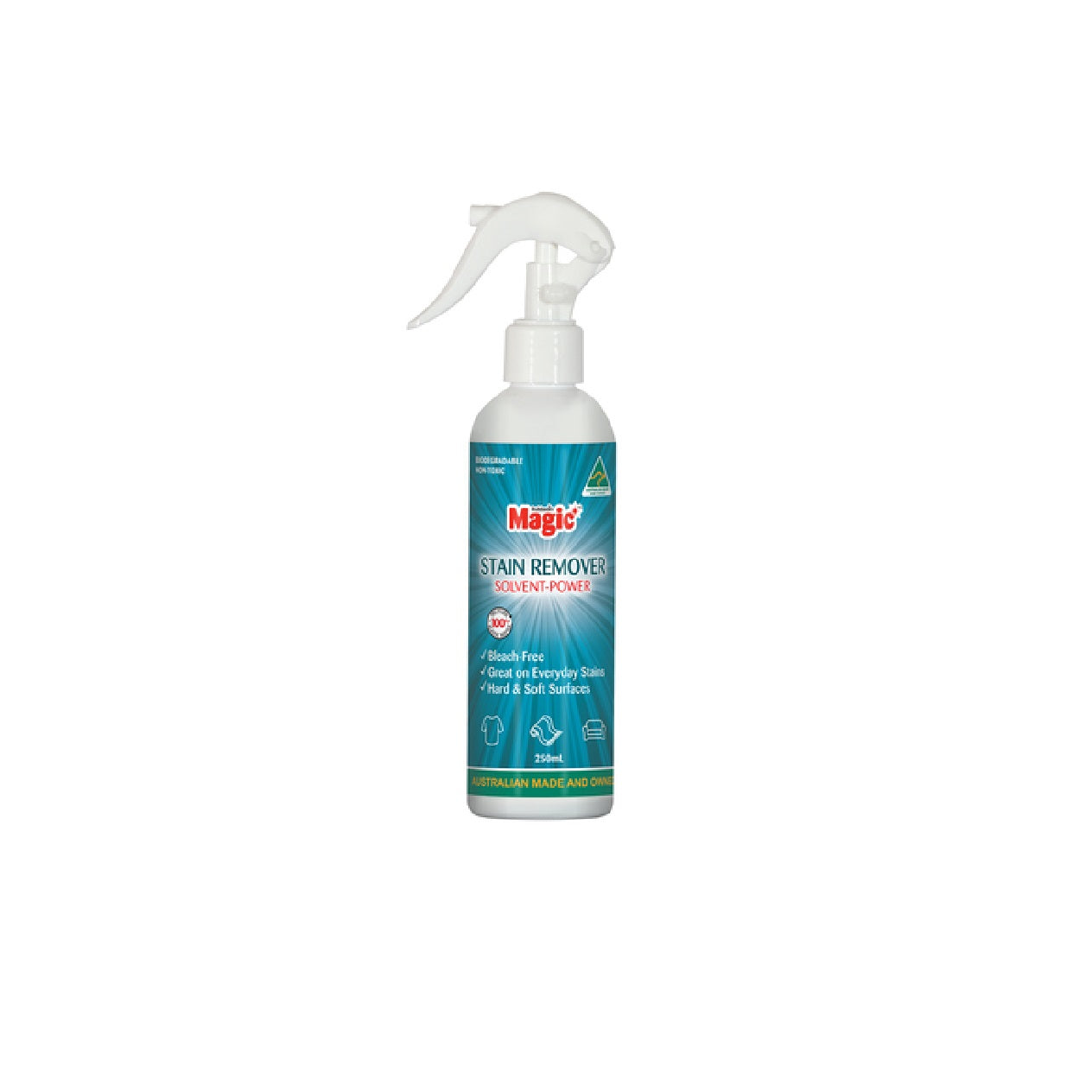
-
Why Use Magic Stain Remover?
- It has been specifically formulated to target tough stains like grease, oil, wine, and food spills. It’s easy to use and often requires minimal scrubbing compared to DIY solutions. It also works on a variety of fabric types, including synthetic outdoor cushions. It can be a quick fix for stubborn stains that don’t respond to soap, vinegar, or OxiClean.
-
Steps for General Use:
- Place your cushions on a clean surface and remove any residue from the stain.
- Shake the bottle and unlock the sprayer as described earlier.
- Apply Magic Solvent-Power Stain Remover directly to the stain, and gently work it into the fabric with a clean cloth.
- Allow it to sit for up to 10 minutes, depending on the stain’s severity.
- Blot the stain with a damp cloth to lift the stain away. Keep blotting to remove excess liquid and the stain should come off.
- Wash the cushion using one of the other described methods.
- Allow the cushion to dry.
-
What to Consider Before Using Magic Stain Remover:
- Check for fabric compatibility; some removers contain chemicals that may fade or weaken certain materials.
- This may not be effective for deep mould or mildew, so consider stronger solutions like bleach for severe cases.
- Some removers leave behind a chemical scent or residue, so test in an inconspicuous area first.
- It’s not always eco-friendly—if sustainability is a concern, opt for vinegar or mild soap instead.
Frequently Asked Questions (FAQs)
Can You Wash Outdoor Cushions in the Washing Machine?
You can wash some outdoor cushions in the washing machine, but it's always best to read the care label first to determine if your outdoor cushions are suitable for machine washing. Some have removable covers that can be washed on a delicate cycle, while others are better off being hand-washed.
Can You Bleach Outdoor Cushions?
You can use bleach on some outdoor cushions, but it’s crucial to check the fabric's care label first; some fabrics may be weakened or faded by bleach. If you're dealing with mould or mildew, consider using oxygen bleach or vinegar instead.
Can You Put Outdoor Cushions In The Dryer?
Most outdoor cushions can't be put in the dryer as they will shrink. It's better to let them air-dry in the sun instead.
How Do You Remove Grass Stains From Outdoor Cushions?
The best way to get grass stains off an outdoor cushion is to dab the stain with white vinegar or rubbing alcohol and then blot it with a cloth. You can also apply baking soda and detergent, allow it to sit, and then rinse it off.
What Are The Best Cleaning Solutions For Outdoor Cushions?
To keep your outdoor cushions fresh and well-maintained, especially against mould and mildew, here are some of the best cleaning solutions:
- Dish Soap Solution: Mix ¼ cup of dish soap with a gallon of water. Scrub the cushions with a soft-bristled brush and rinse thoroughly with a hose.
- White Vinegar Solution: Spray distilled white vinegar directly onto the cushions, let it sit for 10 minutes, then scrub with a mixture of warm water and dish soap.
- Borax Solution: Combine 1 cup of Borax with water and dish soap in a bucket. Scrub the cushions thoroughly, let the solution sit, then rinse with a hose.
- Bleach Solution (For White or Bleachable Fabrics): Mix ¾ cup of bleach with a gallon of water. Apply carefully using a cloth or brush, then rinse well.
- Pressure Washer Method: For a deep clean, use a pressure washer with a low setting and a suitable cleaner to remove mould and dirt effectively.
Always allow cushions to dry completely in a sunny, well-ventilated area to prevent future mould growth.
When Should I Clean My Outdoor Cushions?
Outdoor cushions should be cleaned whenever a spill or stain happens, or when they get bird droppings on them. It’s also wise to clean them at the start and end of the outdoor season, or any time you notice a musty smell.
How Often Should I Clean My Outdoor Cushions?
During high-use periods, you should clean your cushions once a month, as well as seasonally. It’s also wise to clean them as soon as they are dirtied in some way to reduce the risk of stains setting.
What's the Best Way to Dry Outdoor Cushions After Cleaning?
To dry outdoor cushions after they’ve been cleaned, start by pressing out excess water using a towel. You can then put them in a sunny spot with good airflow. Don’t machine dry them or store them damp, as they may mould.
How Do I Store Outdoor Cushions to Keep Them Clean And In Good Condition?
Where possible, store outdoor cushions in a cool, dry place, such as a shed, storage bench, or garage, using breathable storage bags to protect them. Clean and dry cushions before storing them, and avoid plastic bags, which may trap humidity and cause mould.
Can I Use a Steam Cleaner on Outdoor Cushions?
Steam cleaners can be effective for removing stains and dirt, but always read the cushion’s care label first. Avoid using them on delicate or heat-sensitive fabrics and make sure the cushion dries completely.
Reference Sources
External References
- Stain Remover Spray 250mL - Rubbedin
-
Superheated Steam vs High Pressure Cleaning: An In-Depth Comparison
-
Are bird droppings hazardous? Here’s the science behind bird poop.
-
How to Clean Outdoor Cushions, Curtains & Furniture | OxiClean™

